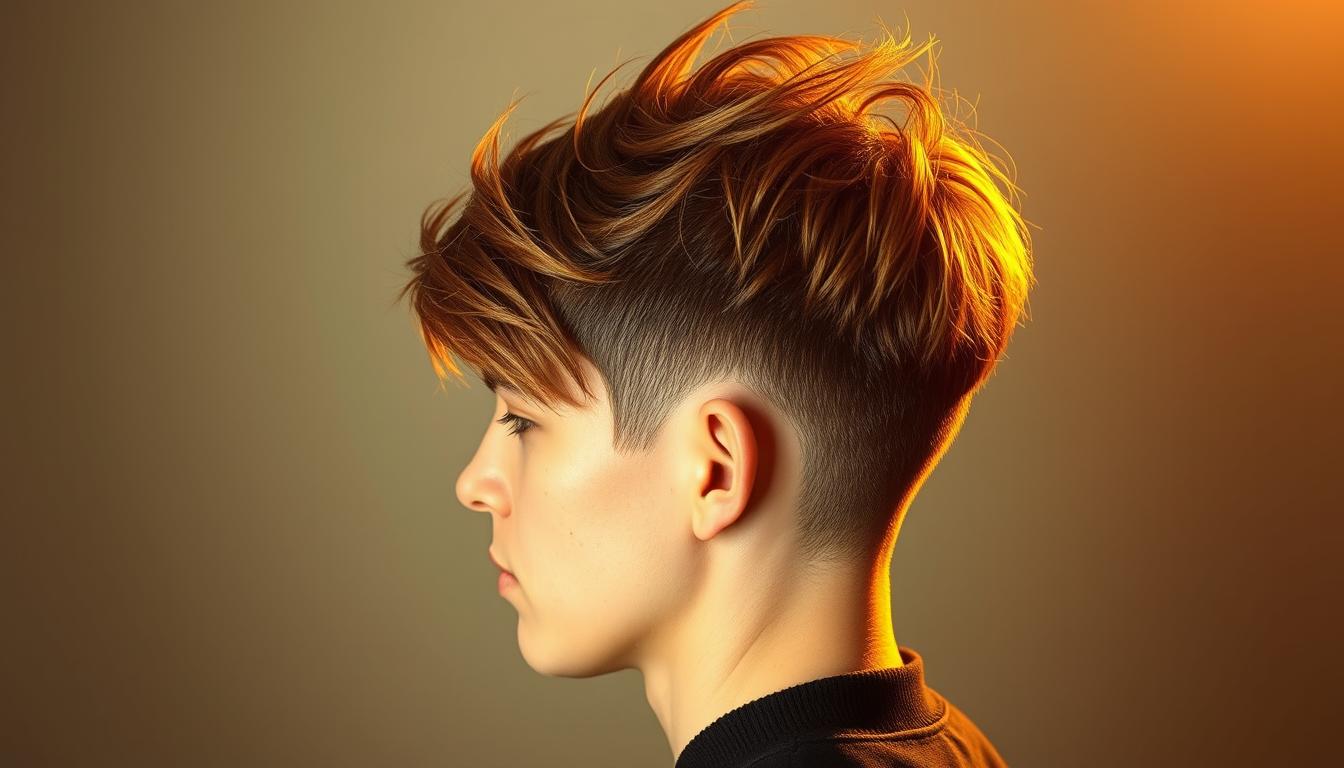
Think your current look blends into the crowd? The hairstyle making waves today isn’t just a throwback – it’s a rule-breaking fusion of attitude and precision. Originally born from rebellion, this iconic cut has been reimagined for modern men who crave versatility without sacrificing edge.
Once synonymous with rockstars and outsiders, today’s version balances sharp tailoring with untamed personality. It works for boardrooms and weekend adventures, adapting to straight, wavy, or coiled textures. The secret lies in strategic contrast – shorter sides that highlight facial structure while longer lengths up top add dramatic movement.
Celebrities and athletes have embraced this hybrid approach, proving it’s more than a passing trend. Your barber becomes a collaborator here, blending technical fade artistry with your unique growth patterns. The result? A silhouette that evolves with your life while always commanding attention.
Key Takeaways
- Modern updates transform this retro style into a versatile choice for professional and casual settings
- Customizable lengths and textures ensure compatibility with various face shapes and hair types
- Celebrity adoption has shifted perceptions from niche to mainstream sophistication
- Clear communication with your barber ensures the cut complements your natural features
- Low-maintenance styling routines preserve the look’s sharpness between salon visits
Understanding the Mullet Fade Trend
![]()
The journey from counterculture symbol to mainstream icon is anything but ordinary. This hairstyle’s evolution mirrors shifting attitudes toward self-expression, blending nostalgia with cutting-edge techniques.
The History Behind the Mullet
Born in the 1970s, this look became a badge of defiance for musicians and blue-collar workers alike. David Bowie’s zigzag-styled version and Hulk Hogan’s wrestler persona cemented its place in pop culture. As country singer Billy Ray Cyrus sang about “achy breaky hearts,” his signature cut became a blueprint for rural America.
Its iconic “business up front, party out back” design offered practical duality. Factory workers kept hair clear of machinery while showcasing personality through longer locks. Rolling Stone noted it was “more than a style – it was a middle finger to conformity.”
Why It’s Making a Comeback Today
Gen Z and millennials revived the silhouette by pairing retro vibes with modern barbering. Tapered sides create cleaner lines, while textured tops add urban edge. Celebrities like Zendaya and Lil Nas X flipped gender norms, proving this look transcends traditional boundaries.
- 2021’s “mullet revolution” saw a 271% spike in Google searches
- Salons report 40% of male clients request faded versions
- Stylists use thinning shears for wearable texture
Today’s iterations work for corporate jobs or concert pits, adapting to any hair type. It’s not just a cut – it’s cultural rebellion 2.0.
Exploring Diverse Mullet Hairstyles for Every Personality

Your hair tells a story before you speak. Today’s updated takes on this iconic cut prove rebellious roots can coexist with polished versatility. Whether you’re chasing boardroom approval or concert mosh pits, there’s a tailored version waiting to amplify your vibe.
Tailored Textures for Modern Rebels
The contemporary approach sharpens the original concept. Think cropped sides blending into a textured crown, creating subtle contrast that works under studio lights or fluorescent office bulbs. “It’s about controlled chaos,” says NYC stylist Marco Rivera. “Clients want structure without losing that rockstar energy.”
Curly textures thrive here – natural coils add volume that defies gravity. For straighter hair, barbers use point-cutting techniques to create wearable movement. The shaggy variation leans into 1970s nostalgia with feathered layers that catch the light like guitar strings.
Mastering Proportion Through Length
Short versions keep maintenance minimal – think two-inch tops with tapered necks. These work for corporate jobs or humid climates where styling time matters. Longer styles demand commitment but reward with head-turning drama. A six-inch back section paired with disconnected sides creates runway-ready contrast.
Your face shape dictates ideal lengths. Oval profiles handle extreme variations, while square jaws benefit from softer transitions. Wavy textures often shine at medium lengths, letting natural bends create organic flow without product overload.
Mullet Fade: Techniques and Styling Tips
Your barber’s chair becomes an artist’s studio when crafting this look. The magic happens through calculated clipper work and strategic texturizing that maintains edge while ensuring wearability. Clear communication about your lifestyle needs ensures the final mullet fade enhances your natural features.
Step-by-Step Process to Achieve the Look
Start by deciding your fade height. Low placements near the ears create subtle contrast, while high fades make bold statements. Your barber will typically:
- Establish length guidelines for top and back sections
- Use clippers with decreasing guard sizes on the sides
- Blend transitions with thinning shears
| Fade Type | Contrast Level | Best For |
|---|---|---|
| Low Taper | Subtle | Office environments |
| Mid Burst | Moderate | Curly textures |
| High Fade | Dramatic | Straight hair |
| Burst Fade | Circular dimension | Square face shapes |
Texturizing and Blending Your Fade
Professional stylists use point-cutting to remove bulk without sacrificing movement. For burst fade applications, they create circular tapering around the ears that flows into longer lengths. This technique adds depth to thicker hair types while maintaining clean lines.
Finish with a matte pomade for piece-y separation or sea salt spray for natural waves. Remember: the best styles adapt as they grow out, so schedule trims every 3-4 weeks to keep your silhouette sharp.
Essential Hair Products and Tools for a Bold Look
Your styling arsenal determines whether your look fizzles or sizzles. The right combinations transform basic cuts into head-turning statements while protecting your hair’s health. Let’s break down the game-changers you need.
Volumizing Shampoos and Sea Salt Sprays
Start with a volumizing shampoo that cleanses without stripping natural oils. These formulas lift roots while adding thickness – crucial for styles needing body. Pair with lightweight conditioners to avoid weighing strands down.
Sea salt spray becomes your texture secret weapon. Spritz damp hair before blow-drying to create beachy separation. “This product mimics wind-blown coastal air,” says stylist Jenna Cole. “It gives that ‘effortless’ grip without crunch.”
Styling Clays, Pomades, and Diffusers
Matte clays offer flexible hold for reworkable styles. Rub a dime-sized amount between palms, then rake through dry hair for piece-y definition. For spikier looks, try firm-hold pomades that withstand humidity.
Curly textures thrive with diffusers. Attach this tool to your blow dryer to enhance natural coils while reducing frizz. Finish with texturizing powder at the roots – it absorbs oil and adds lift for fine hair types.
| Product | Best For | Pro Tip |
|---|---|---|
| Sea Salt Spray | Wavy textures | Apply to damp hair |
| Styling Clay | Matte finishes | Warm in hands first |
| Diffuser | Curly volume | Use medium heat |
Customizing Your Mullet Fade for Different Hair Types
Your hair’s natural texture isn’t a limitation—it’s your style superpower. This versatile cut adapts to coils, waves, and straight strands when approached with tailored techniques. The key lies in enhancing what you’ve got while creating balanced proportions.
Maximizing Curl Definition
Natural curls thrive with layered cutting that follows your coil pattern. Ask your barber to point-cut ends for bounce that lasts all day. Leave-in conditioners keep ringlets defined, while diffusers enhance volume at the roots.
Wavy textures benefit from staggered lengths. Longer layers at the crown create flowing movement, while shorter back sections prevent bulk. Use sea salt spray on damp strands before scrunching – it amplifies texture without stiffness.
Elevating Straight & Fine Strands
Straight hair gains edge through strategic texturizing. Razor-cutting adds subtle separation, making styles appear fuller. Apply matte clay to dry hair, focusing on mid-lengths for grip that doesn’t look greasy.
Fine textures need lightweight solutions. Volumizing mousse at the roots paired with dry shampoo adds lasting lift. Avoid overloading with product – less is more for maintaining natural movement.
| Hair Type | Key Technique | Product Match |
|---|---|---|
| Curly | Moisture-focused layers | Curl cream |
| Wavy | Feathered cutting | Sea salt spray |
| Straight | Razor texturizing | Matte clay |
| Fine | Root lifting | Volumizing mousse |
Everyday Inspiration: Modern Takes on a Classic Look
Red carpet rebels are rewriting style rules with daring updates to traditional designs. These fresh interpretations balance nostalgia with contemporary edge, proving bold hairstyles belong in professional settings and city streets alike.
Celebrity-Inspired Variations
Miley Cyrus electrified the mohawk-inspired version, pairing shaved sides with platinum spikes. Her take combines rockstar energy with gender-fluid appeal – a blueprint for those craving high-impact styling. Meanwhile, Troye Sivan’s burst design uses circular tapering to frame angular features, creating dimensional contrast.
Rihanna’s asymmetric iteration proves this cut transcends gender norms. Longer sections cascade over one shoulder, while cropped layers add modern polish. “The key is customization,” notes stylist Jenna Cole. “We adjust proportions to complement bone structure and personal branding.”
Athletes like NBA star Russell Westbrook opt for sharp transitions between faded sides and textured tops. This approach maintains clean lines during games while allowing creative expression off-court. For LGBTQIA+ icons like Tegan and Sara, the style symbolizes unapologetic self-expression through its mix of precision and rebellion.
- Mohawk fusion: Edgy shaved areas meet voluminous crowns
- Burst dimension: Circular fading emphasizes facial contours
- Asymmetric flow: Contrasting lengths create visual intrigue
These adaptations prove the look’s versatility – from boardroom-ready fades to concert-wild textures. Your version might incorporate subtle highlights or unexpected parting techniques that mirror your daily adventures.
Maintaining Your Mullet Fade: Grooming and Aftercare
Keeping your signature style sharp requires more than initial precision. Regular upkeep preserves the dynamic contrast between cropped sides and textured lengths while preventing awkward growth phases. Consistency is key – a well-maintained cut looks intentional, not accidental.
Effective Trim and Maintenance Routines
Schedule professional touch-ups every 2-3 weeks for mid fades. High-contrast styles demand more frequent visits – every 10 days prevents blurred lines. Use a quality clipper at home to maintain the sides between appointments, keeping guards one size larger than your original cut.
| Fade Type | Maintenance Frequency | Home Care Tip |
|---|---|---|
| Low | 3 weeks | Use #2 guard |
| Mid | 2 weeks | Blend with thinning shears |
| High | 10 days | Edge razor weekly |
Clarifying shampoo removes product buildup every 7 days. Follow with hydrating conditioner to prevent dryness, especially important for colored or processed strands.
Adjusting Your Style as It Grows Out
During growth phases, experiment with matte pastes to slick back elongating sections. For burst designs losing definition, a curved trimmer recreates fading gradients temporarily. “Growth stages offer creative opportunities,” notes barber Luis Torres. “Push strands forward for faux bangs or twist longer pieces into mini ponytails.”
When proportions feel unbalanced – typically around week 6 – book a reshaping session. Your stylist can extend the transition zone while preserving the style’s character. This bridges the gap between major cuts without sacrificing edge.
Conclusion
In an era where individuality reigns supreme, your hairstyle becomes your signature. Experts predict this iconic cut will dominate 2025’s style landscape as self-expression trumps tradition. Its adaptability—tapered sides meeting textured lengths—resonates with professionals and creatives alike.
What fuels its enduring appeal? Versatility. This look thrives on personalization, whether you prefer subtle office-ready blends or dramatic contrasts. It’s not just about following trends—it’s about crafting a visual identity that evolves with your life’s chapters.
Barbers now consider face shape, hair texture, and lifestyle when designing these styles. The result? A harmonious balance between polished precision and rebellious flair. As gender norms dissolve, this option empowers everyone to redefine modern edge.
Your next salon visit isn’t just a trim—it’s a statement. Embrace the freedom to merge classic roots with contemporary artistry. After all, true style isn’t worn—it’s lived.
